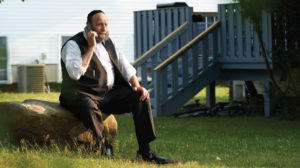The Gardener: Part II


Meira: A PET?! This is what I mean when I say she’s totally inappropriate.
Therapist: It’s not about pets per se — it’s about accepting Suri’s individuality.
Bubby: Nu, what’s wrong with animals?
Suri slumps into her chair at her first session with her typical sullen expression [Suri doesn’t realize that her behavior plays a role in the way others perceive her and respond to her].
“Good morning,” I say.
Suri mumbles a reply.
I allow a minute of silence to pass. “That was very interesting.”
She looks annoyed. “I didn’t say anything.”
“What do you mean? You’ve been talking nonstop since you walked in.”
She stares blankly.
“It’s a secret language,” I explain. “It’s called ‘body language.’” I slouch down into my chair and stare at my toes, imitating Suri. “What am I saying now?” I don’t wait. “I’m saying, ‘I don’t wanna be here,’ right?”
Suri says nothing.
“The cool thing about this secret language is that you speak it all day long whether you want to or not. You’re always communicating through your body language. And if you don’t know the language, you might say the wrong thing. That’s what we’re here to work on.”
I play a video clip for Suri. It shows a class engaged in a spirited game of ball, except for one student, who sits on the side in a pose similar to Suri’s. “What’s her body language saying?” I ask.
“She wants to be alone.”
“Great! Now if she’d want to have company, how could she communicate that?” I sit up straight and look around with a relaxed, open look on my face. “This kind of body language is more inviting. It tells people, ‘I’m in a friendly mood.’”
We go through cards showing people with various expressions, discussing what their body language is communicating [Suri is missing what everyone around her does naturally].
“I like that,” Suri says, pointing to a picture of a boy walking a dog. “I wish I had a pet. A kitty. Or even a bunny.”
I hand Suri a mirror. “Quick, look at your face! You look alive, animated, interested.” I draw her attention to her open, lively eyes, subtle smile, and raised eyebrows. “This kind of body language says, ‘I’m interested! I care!’ That’s the expression you should have whenever someone talks to you. It shows you care about what they care about” [Caring about others’ interests demonstrates that you value the other person, and is a first step in building relationships].
Our successive sessions build on this concept. I teach Suri about “voicing,” which is like body language with your voice — its tone, pace, and emphasis. We practice speaking clearly and pausing in the right places. The goal is for Suri to develop an inviting manner of speech — no mumbling.
“Presentation is everything,” I quip.
Suri rolls her eyes. “That’s why my mother buys me these fancy clothes. I hate them.”
“Want to hear another secret? It doesn’t matter what you wear. It matters how you wear it. When your fancy socks are scrunched up at your ankles and your fancy shirt is untucked, that communicates you don’t care. And if you don’t respect yourself, will others respect you?”
Suri sits up straight and fixes her headband. “So I can wear whatever I want?”
Progress.
Originally featured in Family First, Issue 625.
D. Himy, M.S. CCC-SLP, is a speech-language pathologist in private practice for over 15 years. She is the creator of the Link-It reading comprehension and writing curriculum for elementary school students and directs continuing education programs for speech-language pathologists and educators.
Oops! We could not locate your form.









